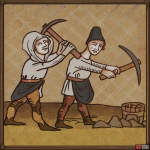Text
While in the medieval quarries the hard work was done by rock cutters and stone masons, in the mines skilled labourers - miners worked for wages. It was tough work. Using only hammers and chisels (these tools are depicted on the first Kuttenberg coat of arms) and by the light of small hand-held lamps, did they extract the valuable ore.
Mining in the rock was slow, but thanks to perseverance and shift work, they eventually dug underground tunnels reaching hundreds of metres (sometimes up to 450m). This created larger and more passable horizontal and vertical shafts - underground pits - from which smaller galleries ran out in chains, where miners had to literally crawl on all fours. Safe movement in such conditions was ensured by unique, durable clothing, the most essential parts of which were a leather apron and knee pads.
The arduous and prolonged work was expedited by a method called fire setting. A fire was set at the end of the shaft, cracking the rock, and making it easier to chip away. Even so, mining was dangerous and exhausting, and miners’ wives often became widows many times over.
Every miner was thoroughly searched when leaving his shift, because the silver belonged to the king and there were severe penalties for theft. Still, they did occur, for as the age-old saying goes: ‘The brazen miners on the rocks, have work until Saturday, but money only until Sunday.’


No Comments